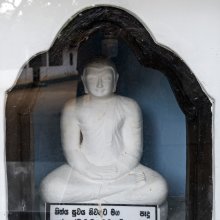Darshin, Darśī, Darśin, Darshi: 16 definitions
Introduction:
Darshin means something in Buddhism, Pali, Hinduism, Sanskrit, Jainism, Prakrit, Marathi, Hindi, biology. If you want to know the exact meaning, history, etymology or English translation of this term then check out the descriptions on this page. Add your comment or reference to a book if you want to contribute to this summary article.
The Sanskrit terms Darśī and Darśin can be transliterated into English as Darsi or Darshi or Darsin or Darshin, using the IAST transliteration scheme (?).
Images (photo gallery)
In Hinduism
Shaktism (Shakta philosophy)
Source: Google Books: ManthanabhairavatantramDarśin (दर्शिन्) refers to “one who explains”, according to the Manthānabhairavatantra, a vast sprawling work that belongs to a corpus of Tantric texts concerned with the worship of the goddess Kubjikā.—The Yogakhaṇḍa insists that the sacred seats should be honoured and respected as are the teacher and the scriptures. Knowledge of the seats and travelling to them is an essential characteristic of the teacher. More specifically, the teacher should not only know and explain the Krama (krama-darśin), he should also know this group of eight sacred seats. It is considered to be so fundamental by Yogakhaṇḍa (1) that the worship of it is listed as one of the characteristics of the Western Tradition

Shakta (शाक्त, śākta) or Shaktism (śāktism) represents a tradition of Hinduism where the Goddess (Devi) is revered and worshipped. Shakta literature includes a range of scriptures, including various Agamas and Tantras, although its roots may be traced back to the Vedas.
Shaivism (Shaiva philosophy)
Source: Brill: Śaivism and the Tantric Traditions (philosophy)Darśin (दर्शिन्) refers to “those who know (reality)”, according to the Nyāyamañjarī, vol. I, 326.—Accordingly, “[...] Among these [two types of inference,] who would not admit the validity of an inference such as that [of fire] from smoke? So [people] apprehend what is to be established [by such an inference] even though they are not pestered by logicians. But the validity of an inference regarding such [entities] as the Self, God, an omniscient or an afterlife is not acknowledged by those who know reality (tattva-darśin)”.

Shaiva (शैव, śaiva) or Shaivism (śaivism) represents a tradition of Hinduism worshiping Shiva as the supreme being. Closely related to Shaktism, Shaiva literature includes a range of scriptures, including Tantras, while the root of this tradition may be traced back to the ancient Vedas.
In Buddhism
Mahayana (major branch of Buddhism)
Source: academia.edu: A Study and Translation of the GaganagañjaparipṛcchāDarśin (दर्शिन्) refers to “one who sees” (eg., ‘one who sees imperfections as a danger’), according to the Gaganagañjaparipṛcchā: the eighth chapter of the Mahāsaṃnipāta (a collection of Mahāyāna Buddhist Sūtras).—Accordingly, as Gaganagañja said to Ratnapāṇi: “Son of good family, those sixty-four dharmas are included in one hundred twenty-eight dharmas. What are those one hundred twenty-four? [...] (25) love is included in faultlessness and not concealing one’s own mistakes; (26) having faith in the maturation of action is included in being careful in this life and seeing imperfections as a danger (avadyeṣu bhaya-darśin) for the next world; (27) little desire is included in properly grasping and not being satisfied with insight; (28) knowing satisfaction is included in being easily satisfied with food; [...]’”.

Mahayana (महायान, mahāyāna) is a major branch of Buddhism focusing on the path of a Bodhisattva (spiritual aspirants/ enlightened beings). Extant literature is vast and primarely composed in the Sanskrit language. There are many sūtras of which some of the earliest are the various Prajñāpāramitā sūtras.
In Jainism
General definition (in Jainism)
Source: The University of Sydney: A study of the Twelve ReflectionsDarśin (दर्शिन्) refers to “those who know (the self)”, according to the 11th century Jñānārṇava, a treatise on Jain Yoga in roughly 2200 Sanskrit verses composed by Śubhacandra.—Accordingly, “Those who know the self (ātma-darśin) certainly destroy mental darkness, which is produced by the great quantity of ignorance [and] is a barrier to reality, with the sunbeams of knowledge. One who is restrained who is intent on stopping the influx of karma fearlessly drives away the discharge of the poison of non-restraint with the nectar waters of true restraint”.

Jainism is an Indian religion of Dharma whose doctrine revolves around harmlessness (ahimsa) towards every living being. The two major branches (Digambara and Svetambara) of Jainism stimulate self-control (or, shramana, ‘self-reliance’) and spiritual development through a path of peace for the soul to progess to the ultimate goal.
Biology (plants and animals)
Source: Google Books: CRC World Dictionary (Regional names)Darsin in Nepal is the name of a plant defined with Terminalia alata in various botanical sources. This page contains potential references in Ayurveda, modern medicine, and other folk traditions or local practices It has the synonym Pentaptera tomentosa Roxb. ex DC., nom. illeg., nom. superfl. (among others).
Example references for further research on medicinal uses or toxicity (see latin names for full list):
· Cat. Ind. Pl. (1833)
· Prodr. (1828)
· Prodr. Flora Indica, or ‘Descriptions of Indian Plants’ Orient. (1834)
· Novae Plantarum Species praesertim Indiae Orientalis (1821)
If you are looking for specific details regarding Darsin, for example side effects, diet and recipes, pregnancy safety, chemical composition, extract dosage, health benefits, have a look at these references.

This sections includes definitions from the five kingdoms of living things: Animals, Plants, Fungi, Protists and Monera. It will include both the official binomial nomenclature (scientific names usually in Latin) as well as regional spellings and variants.
Languages of India and abroad
Marathi-English dictionary
Source: DDSA: The Molesworth Marathi and English DictionaryDarśī (दर्शी).—a (S) That sees. In comp. as guṇadarśī, chidradarśī, dīrghadarśī, dūradarśī, dōṣadarśī, pariṇāmadarśī, ātmadarśī, viśvadarśī, sūkṣmadarśī, alpadarśī, tatvadarśī, paryantadarśī.
Source: DDSA: The Aryabhusan school dictionary, Marathi-EnglishDarśī (दर्शी).—a That sees. In comp. as chidradarśī.
Marathi is an Indo-European language having over 70 million native speakers people in (predominantly) Maharashtra India. Marathi, like many other Indo-Aryan languages, evolved from early forms of Prakrit, which itself is a subset of Sanskrit, one of the most ancient languages of the world.
Sanskrit dictionary
Source: DDSA: The practical Sanskrit-English dictionaryDarśin (दर्शिन्).—a. [dṛś-ṇini] (At the end of comp.)
1) Seeing, perceiving, viewing, observing, knowing, understanding, showing, exhibiting; तद्दर्शिनमुदासीनं त्वामेव पुरुषं विदुः (taddarśinamudāsīnaṃ tvāmeva puruṣaṃ viduḥ) Kumārasambhava 2.13.
2) Receiving, securing; नृपतिरिव निकाम- मायदर्शी (nṛpatiriva nikāma- māyadarśī) Mṛcchakaṭika 2.7.
3) Experiencing; Rām.3.
Source: Cologne Digital Sanskrit Dictionaries: Edgerton Buddhist Hybrid Sanskrit DictionaryDarśin (दर्शिन्).—(-darśin) (from Sanskrit darśa, aspect, plus -in), having the aspect of, resembling, like: tathāgatadarśī ca veditavyo Saddharmapuṇḍarīka 226.8 (prose), and he is to be regarded as like a T. (because he has similar qualities and behavior; compare lines 1—2 above, sa hi…tathāgato veditavyaḥ; so Kern, clearly rightly; Burnouf, wrongly, as having seen the T.).
Source: Cologne Digital Sanskrit Dictionaries: Benfey Sanskrit-English DictionaryDarśin (दर्शिन्).—i. e. dṛś + in, adj., f. nī. 1. Looking; sama-, Looking indifferently on every object, [Bhagavadgītā, (ed. Schlegel.)] 5, 18. 2. Knowing, [Mānavadharmaśāstra] 3, 212; divya-, Knowing celestial things, Mahābhārata 15, 566. 3. Having seen, [Kathāsaritsāgara, (ed. Brockhaus.)] 25, 297. 4. Showing, [Rāmāyaṇa] 2, 75, 12. 5. Teaching, Mahābhārata 1, 522.
Source: Cologne Digital Sanskrit Dictionaries: Cappeller Sanskrit-English DictionaryDarśin (दर्शिन्).—[adjective] (—°) seeing, beholding, knowing, understanding, finding out, inventing, showing, teaching.
Source: Cologne Digital Sanskrit Dictionaries: Monier-Williams Sanskrit-English Dictionary1) Darśin (दर्शिन्):—[from darśa] mfn. ifc. seeing, looking at, observing, examining, finding, [Mahābhārata viii, 1757; Rāmāyaṇa] etc.
2) [v.s. ...] knowing, understanding, (G), [ii, 64, 3; Śakuntalā i, 16/17; Raghuvaṃśa xiv, 71; Kumāra-sambhava ii, 13; Hitopadeśa i]
3) [v.s. ...] receiving, [Mṛcchakaṭikā ii, 7]
4) [v.s. ...] experiencing, [Rāmāyaṇa iii, 65, 11]
5) [v.s. ...] composer (of a hymn, sūta-)
6) [v.s. ...] looking, appearing, iv, 40, 48
7) [v.s. ...] showing, exhibiting, teaching, [Mahābhārata; Śakuntalā iv, 21/22; Kathāsaritsāgara lvi, 203]
8) [v.s. ...] inflicting (cf. pāpa-), [Rāmāyaṇa ii, 75, 2; Harivaṃśa]
Source: DDSA: Paia-sadda-mahannavo; a comprehensive Prakrit Hindi dictionary (S)Darśin (दर्शिन्) in the Sanskrit language is related to the Prakrit words: Daṃsi, Darisi, Passi.
[Sanskrit to German]
Sanskrit, also spelled संस्कृतम् (saṃskṛtam), is an ancient language of India commonly seen as the grandmother of the Indo-European language family (even English!). Closely allied with Prakrit and Pali, Sanskrit is more exhaustive in both grammar and terms and has the most extensive collection of literature in the world, greatly surpassing its sister-languages Greek and Latin.
Hindi dictionary
Source: DDSA: A practical Hindi-English dictionaryDarśī (दर्शी):——a suffix meaning he who can see or that which can help see, e.g, [dūra~, krāṃta~, sūkṣma~, trikāla~]; (a) seeing, viewing.
...
See also (Relevant definitions)
Ends with (+65): Adhvadarshin, Adirghadarshin, Adoshadarshin, Aihikadarshin, Amoghadarshin, Anarthadarshin, Anavamadarshin, Anavaranadarshin, Anicadarshin, Anichadarshin, Anichidarshin, Anicidarshin, Anrittadarshin, Anudarshin, Aparinamadarshin, Arthadarshin, Asadhudarshin, Asamyagdarshin, Atidarshin, Atmadarshin.
Full-text (+111): Sukshmadarshin, Bhayadarshin, Samadarshin, Parinamadarshin, Mantradarshin, Dirghadarshita, Atidarshin, Papadarshin, Sukshmadarshita, Shastradarshin, Sarvadarshin, Vidhidarshin, Karya-darshin, Anicadarshin, Camatarici, Bhavadarshin, Dvaradarshin, Nishadarshin, Prithudarshin, Dirghadarshin.
Relevant text
Search found 21 books and stories containing Darshin, Darshi, Darśī, Darsi, Darsin, Darśin; (plurals include: Darshins, Darshis, Darśīs, Darsis, Darsins, Darśins). You can also click to the full overview containing English textual excerpts. Below are direct links for the most relevant articles:
Shrimad Bhagavad-gita (by Narayana Gosvami)
Verse 5.18 < [Chapter 5 - Karma-sannyāsa-yoga (Yoga through Renunciation of Action)]
Verse 4.35 < [Chapter 4 - Jñāna-Yoga (Yoga through Transcendental Knowledge)]
Verse 13.35 < [Chapter 13 - Prakṛti-puruṣa-vibhāga-yoga]
The history of Andhra country (1000 AD - 1500 AD) (by Yashoda Devi)
Part 2 - Asnadevaraja (A.D. 1385) < [Chapter XV - The Nagas]
Part 16 - Abhidevamalideva’s Maharaja (A.D. 1218-1269) < [Chapter XII - The Pallavas]
Part 1 - The Nagas of Darsi < [Chapter XV - The Nagas]
Garga Samhita (English) (by Danavir Goswami)
Verse 8.13.100 < [Chapter 13 - A Thousand Names of Lord Balarāma]
Tiruvaymoli (Thiruvaimozhi): English translation (by S. Satyamurthi Ayyangar)
Pasuram 10.2.9 < [Section 2 - Second Tiruvaymoli (Ketum itar)]
Amaravati Art in the Context of Andhra Archaeology (by Sreyashi Ray chowdhuri)
Lower Kṛṣṇā Valley (15): Chandavaram < [Chapter 2 - Amarāvatī and other Archaeological Sites of Ancient Andhra Pradesh]
Shat-cakra-nirupana (the six bodily centres) (by Arthur Avalon)



